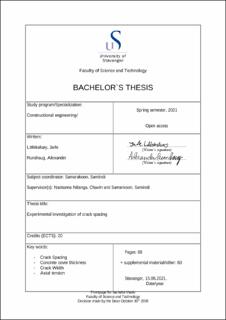| dc.contributor.advisor | Samarakoon, Samindi | |
| dc.contributor.advisor | Naotunna, Chavin Nilanga | |
| dc.contributor.author | Litlekalsøy, Jarle Smeland | |
| dc.contributor.author | Runshaug, Alexander | |
| dc.date.accessioned | 2021-09-07T16:27:51Z | |
| dc.date.available | 2021-09-07T16:27:51Z | |
| dc.date.issued | 2021 | |
| dc.identifier | no.uis:inspera:78877253:36581062 | |
| dc.identifier.uri | https://hdl.handle.net/11250/2774326 | |
| dc.description.abstract | Cracks in concrete structures have an effect on both the durability and the visuals of the structure.
Therefore, it is important to control the cracks in reinforced concrete structures. This thesis address
the difference in concrete cover thickness and how it affects the crack spacing and width. The
concrete cover thickness is an important parameter when calculating the crack spacing and width
of a reinforced concrete structure. From the Eurocode 2 and the Model Code 2010 the concrete
cover is very deciding when calculating the crack spacing and width. This thesis compares the
results from an experiment consisting of three different cover thicknesses against the results using
the calculations from the current standards. Earlier studies suggests that the formulations in the
current standards regarding the crack spacing and the crack width are questionable. The experiment
for this thesis contained of testing six reinforced concrete specimens by applying axial tensile load. | |
| dc.description.abstract | Cracks in concrete structures have an effect on both the durability and the visuals of the structure.
Therefore, it is important to control the cracks in reinforced concrete structures. This thesis address
the difference in concrete cover thickness and how it affects the crack spacing and width. The
concrete cover thickness is an important parameter when calculating the crack spacing and width
of a reinforced concrete structure. From the Eurocode 2 and the Model Code 2010 the concrete
cover is very deciding when calculating the crack spacing and width. This thesis compares the
results from an experiment consisting of three different cover thicknesses against the results using
the calculations from the current standards. Earlier studies suggests that the formulations in the
current standards regarding the crack spacing and the crack width are questionable. The experiment
for this thesis contained of testing six reinforced concrete specimens by applying axial tensile load. | |
| dc.language | eng | |
| dc.publisher | uis | |
| dc.title | Eksperimentell undersøkelse av rissavstand | |
| dc.type | Bachelor thesis | |
